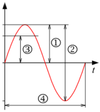Waves Vocabulary Flashcards
waves
The number of ocean waves that pass by a bouy in one second is called the ________________ of the wave.
Frequency

Reflection
When a wave “bounces” off of a boundary between two mediums.

Frequency
How often a wave passes a certain point in one second.
It can be measured in:
cycles/second,
waves/second,
or hertz
The _____________ of a transverse wave is its highest point.
Crest

Transmission
When a waves passes through the boundary between two mediums.

Bow Wave
A V-shaped wave created by a boat whenever the boat is moving faster than the waves move across the water.

Propagation

The repetative process a wave uses to move itself though the medium.
When you squeeze the coils of a spring together, you create a _______________.
Compression

Doppler Effect
In a while, a little button will appear above..
The change in frequency of a wave that results from motion of either the source of the wave or the observer.

In a sound wave, there are high pressure parts called a compressions. What is the name of the low pressure parts in between the compressions?
Rarefactions

Transverse wave
A wave where the medium is dispaced in a direction perpendicular to the direction the wave moves.

Destructive interference
When two waves interfer with each other in such a way that the crests of one wave line up with the troughs of the other.. The wave amplitudes cancel each other out.

__________________ occurs when two waves move into the same space in a medium and combine with each other.
Interference.
-What does this button do?
(by the way, this one doesn’t really work)

It plays any sound that goes with a flashcard. It usually pretty small. Like this…

Pluck a string on a violin. The same string in violin sitting on a table nearby might vibrate in ________________.
Sympathy
(This is called a sympathetic vibration)

The ____________ is the material through which a mechanical wave travels.
Medium
Diffraction

The bending of a wave around an obstacle. This is how you can hear someone who is talking around a corner from you.

When two waves are interfering with each other, sometimes you can see nodes and anti-nodes. It almost looks like the wave is simply staying in one place. This is called a ____________wave.
Standing Wave

When a wave reflects from a surface, we call the wave that bounces off the surface the ____________________ wave.
Reflected

Adding energy at the natural frequency of an object results in _______________.
Resonance

Constructive interference
When two waves interfer with each other in such a way that the crests all line up. The wave amplitudes add.

When a wave reflects off of a surface, we call the incoming wave the __________________ wave.
Incident

In a compressional wave in a coiled spring, a __________ is where the coils are spread out.
Rarefaction

Rest position
(look at the restful water)

The position of the medium when it is allowed to come to a stop.
(Look carefully at the diagram below for the words “rest position.”)

























































































